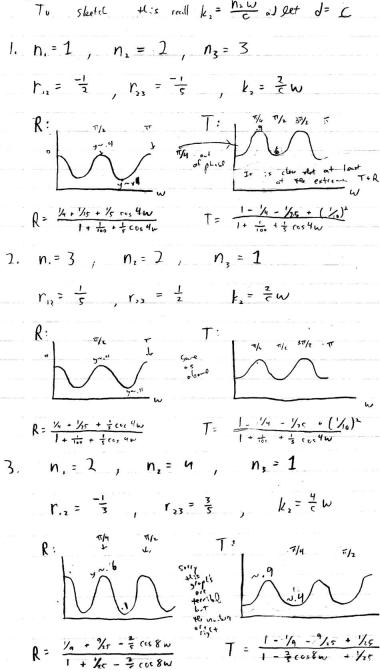
electrodynamics / Companion to J.D. Jackson's Classical Electrodynamics 3rd ed. - R. Magyar
.pdf
The first term corresponds to the reflection at the n1-n2 interface. The second term is a wave which passes through the n1-n2 interface, reflects o the n2-n3 interface, and then transits through the n1-n2 interface. Higher order terms correspond to multiple internal reflections.
Note the phase change over the internal reflection path. It is 2k2d for one round trip from the n1-n2 to the n2-n3 interface and back. k2 is n2cω . The
~
phase shift makes sense because the term in the exponent is really ik · ~r and
~
the distance is ~r = d for the first leg. On the return leg, the sign of both
~ ~
k and d change because the wave is propagating backwards and over the same distance in the opposite direction as before. The total phase change is the product of these two changes and so ikd + i(−k)(−d) = 2ikd. If you are motivated, you could probably show this with matching boundary conditions. I think this heuristic argument su ces.
I’ll write this series in a suggestive form:
h i h i
r = r12 + t12r23t21e2ik2d × 1 + r23r21e2ik2d + (r23r21)2e4ik2d + ...
The second term in the brackets is a geometric series:
∞ |
|
1 |
|
|
|
|
xn = |
|
|
|
, x < 1 |
|
|
1 |
− |
x |
|
|||
X |
|
|
|
|
|
|
n=0 |
|
|
|
|
|
|
and I can do the sum exactly. |
|
|
|
|
|
|
r = r12 + ht12r23t21e2ik2di |
1 |
|
||||
|
||||||
1 − r23r21e2ik2d |
||||||
You can obtain for yourself with the help of Jackson page 306:
rij = |
ni − nj |
= |
ki − kj |
||
ni + nj |
ki + kj |
||||
|
|
||||
And |
|
2ki |
|||
tij = |
2ni |
= |
|||
ni + nj |
ki + kj |
|
|||
With these formulae, I’ll show the following useful relationships:
r |
|
= |
n1 − n2 |
= |
n2 − n1 |
= r |
|
n1 + n2 |
−n1 + n2 |
||||
|
12 |
|
|
− 21 |
47

And |
|
2n1 |
|
|
2n |
|
|
|
4n1n2 |
||||||||
t12t21 = |
|
|
= |
|
|||||||||||||
|
1 |
|
|
|
|
||||||||||||
n1 + n2 |
n1 + n2 |
(n1 + n2)2 |
|||||||||||||||
t t = 1 |
− |
(n1 − n2)2 |
= 1 + r |
12 |
r |
21 |
|
|
|||||||||
12 21 |
|
|
(n1 + n2)2 |
|
|
|
|
|
|
||||||||
Plug these into equation . |
|
|
|
|
|
|
|
|
|
|
|
|
|
|
|||
r = r12 + |
(1 + r12r21)e2ik2d |
|
r12 + r23e2ik2d |
||||||||||||||
|
|
|
|
|
= |
|
|
|
|
|
|
|
|||||
|
|
|
|
2ik2d |
|
|
|
|
|
|
2ik2d |
||||||
|
|
|
1 + r12r23e |
|
1 + r12r23e |
||||||||||||
The reflection coe cient is R = |r|2. |
|
|
|
|
|
|
|
|
|||||||||
R = |
|
|
r122 + r232 + 2r12r23 cos(2k2d) |
||||||||||||||
1 + 2r12r23 cos(2k2d) + (r12r23)2 |
|
||||||||||||||||
And it follows from R + T = 1 that |
|
|
|
|
|
|
|
|
|||||||||
T = |
|
|
1 − r122 − r232 + (r12r23)2 |
|
|
|
|
||||||||||
1 + 2r12r23 cos(2k2d) + (r12r23)2
R + T = 1 is reasonable if we demand that energy be conserved after a long period has elapsed.
Now, here are all the crazy sketches Jackson wants:
48

49

Problem 7.12
The time dependence of electrical disturbances in good conductors is governed by the frequency-dependent conductivity (Jackson’s equation 7.58). Consider longitudinal electric fields in a conductor, using Ohm’s law, the continuity equation, and the di erential form of Coulomb’s law.
a. Show that the time-Fourier transformed charge density satisfies the equation:
[σ(ω) − iωǫ0] ρ(ω) = 0
The continuity equation states
~∂ρf
· Jf = − ∂t
~ ~
From Ohm’s law, Jf = σE so
~ ~ ~
· Jf = · (σEf ) = σ · Ef
~
The last step is true if σ is uniform. According to Coulumb’s law, ·E = We now have
ρ . ǫ0
~ |
~ |
σ |
ρ = − |
∂ρ |
· J = σ · E = |
|
|
||
ǫ0 |
∂t |
|||
From now on, I’ll drop the subscript f . We both know that I mean free charge and current. From the last equality,
∂ρ |
|
|
σρ + ǫ0 ∂t |
= 0 |
(1) |
Assume that ρ(t) can be written as the time Fourier transform of ρ(ω). I.e.
ρ(t) = √1 Z ρ(ω)e−iωtdω
2π
Plug ρ(t) into equation 1.
√1 |
σρ(ω)e−iωt + ǫ0 |
ρ(ω) ∂t e−iωt! dω = 0 |
|||
|
|
Z |
|
|
∂ |
|
|
|
|
|
|
|
2π |
|
|
|
|
For the integral to vanish the integrand must vanish so
[σ − iωǫ0] ρ(ω)e−iωt = 0
50

For all t. We conclude that
[σ(ω) − iωǫ0] ρ(ω) = 0 b. Using the representation,
σ(ω) = σ0
1 − iωτ
where σ0 = ǫ0ωp2τ and τ is a damping time, show that in the approximation ωpτ >> 1 any initial disturbance will oscillate with the plasma frequency and decay in amplitude with a decay constant λ = 21τ . Note that if you use σ(ω) σ(0) = σ0 in part a, you will
find no oscillations and extremely rapid damping with the (wrong)
decay constant λw = σ0 .
ǫ0
From part a, σ(ω) − iǫ0ω = 0. Let ω = −iα so that
σ(ω) = ǫ0ωp2τ 1 − ατ
And the result from part a becomes σ(ω) − ǫ0α = 0 →
ǫ0ωp2τ |
− ǫ0α = 0 → |
ǫ0ωp2τ − ǫ0α + α2τ ǫ0 |
= 0 |
||||
1 |
− |
ατ |
1 |
− |
ατ |
||
|
|
|
|
|
|
||
The numerator must vanish. Divide the numerator by τ ǫ0,
α2 − τ −1α + ωp2 = 0
Solve for α.
1 h q i
α = 2 τ −1 ± τ −2 − 4ωp2
If ωp >> 1, we can write α in an approximate form,
α (2τ )−1 ± iωp
The imaginary part corresponds to the oscillations at ωp, the plasma frequency. The real part is the decay in amplitude 21τ .
51
Problem 7.16
Plane waves propagate in an homogeneous, non-permeable, but anisotropic dielectric. The dielectric is characterized by a tensor ǫij , but if coordinate axes are chosen as the principle axes, the components of displacement along these axes are related to the electric field components by Di = ǫiEi, where ǫi are the eigenvalues of the matrix ǫij .
~
a. Show that plane waves with frequency ω and wave vector k must satisfy
|
|
|
|
|
|
~ |
|
~ |
|
|
~ |
|
|
|
|
|
|
|
|
|
2 ~ |
|
|
|
|
|
|
|
|
|
|
|
|
|
|
|
|
k × (k × E) + µ0ω D = 0 |
|
|
|
|
|||||||||||||||||||||
|
|
|
|
|
|
|
|
|
|
|
|
|
|
|
|
|
|
|
|
|
~ |
|
|
|
|
|
~ |
|
|
|
|
|
|
|
|
|
|
|
|
|
|
|
|
|
|
|
|
|
|
|
|
|
|
|
|
|
|
∂B |
|
|
|
||
Consider the second Maxwell equation, ×E = − |
∂t |
. Take the curl of both |
|||||||||||||||||||||||||||||
|
|
|
|
|
|
|
|
|
|
|
|
|
|
|
|
|
|
|
|
|
|
|
|
|
|
|
|
~ |
|
|
|
sides. Plug in the fourth Maxwell equation for × B. |
|
|
|||||||||||||||||||||||||||||
|
× |
( |
× |
E~ ) = |
|
|
|
|
∂B~ |
|
= |
− |
|
∂ |
µ0J~ + µ0 |
∂D~ |
|
||||||||||||||
|
|
|
|
|
|
|
|
|
|
||||||||||||||||||||||
|
|
|
− × ∂t |
|
|
|
|
|
∂t |
|
|
∂t |
|||||||||||||||||||
~ |
|
|
|
|
|
|
|
|
|
|
|
|
|
|
|
|
|
|
|
|
|
|
|
|
|
|
|
|
|
|
|
When J = 0 this becomes |
|
|
|
|
|
|
|
|
|
|
|
|
|
|
|
|
|
|
|
|
|
|
|
|
|
||||||
|
|
|
|
|
|
× × E~ + |
|
|
∂2 |
|
|
|
|
|
|
|
|
|
|||||||||||||
|
|
|
|
|
|
|
|
|
D~ = 0 |
|
|
||||||||||||||||||||
|
|
|
|
|
|
|
∂t2 |
|
|
||||||||||||||||||||||
|
|
|
|
|
|
|
|
|
|
|
|
|
|
|
|
~ |
|
|
|
|
|
|
|
|
|
|
|
|
|
||
Assume a solution of the form, E~ = E~0ei(k·~r−ωt), and try it. |
|
|
|||||||||||||||||||||||||||||
|
|
|
|
|
|
~ |
~ |
~ |
|
|
|
|
|
|
|
2 |
∂2 |
|
~ |
|
|
|
|
|
|||||||
|
|
|
|
|
|
k × (k × E) + µ0 |
ω |
|
|
∂t2 |
D = 0 |
|
|
||||||||||||||||||
~ |
~ |
~ |
|
|
~ |
|
~ |
|
|
2 |
Ei |
= to write the double curl out in |
|||||||||||||||||||
Use k × (k × E) |
i = ki(k |
· |
E) |
− |
k |
||||||||||||||||||||||||||
expandedh |
form. |
|
i |
|
|
|
|
|
|
|
|
|
|
|
|
|
|
∂2 |
|
|
|
|
|
|
|||||||
|
|
|
|
|
|
~ |
~ |
|
|
2 |
|
|
|
|
|
|
|
|
|
|
2 |
Di |
= 0 |
(2) |
|||||||
|
|
|
|
|
|
ki(k · E) − k |
Ei |
+ µ0ω |
|
∂t2 |
|||||||||||||||||||||
Because Di |
= ǫij Ej , |
|
|
|
|
|
|
|
|
|
|
|
|
|
|
|
|
|
|
|
|
|
|
|
|
|
|
||||
|
|
|
|
|
|
~ ~ |
|
|
2 |
|
|
|
|
|
|
|
|
|
2 |
∂2 |
|
|
|
|
|
||||||
|
|
|
|
|
ki(k · E) − k |
Ei + µ0ω |
|
|
∂t2 |
ǫij Ej = 0 |
|
|
|||||||||||||||||||
~ |
|
|
|
|
|
|
|
|
|
|
|
|
~ |
|
|
|
|
|
|
|
|
|
|
|
|
|
|
|
|
|
|
Note D is not necessarily parallel to E. |
|
|
|
|
|
|
|
|
|
|
|
|
|
|
|
|
|
||||||||||||||
52

~
b. Show that for a given wave vector k = k~n there are two distinct
modes of propagation with di erent phase velocities v = |
ω |
that |
||||
satisfy the Fresnel equation |
|
|
|
|
k |
|
|
|
|
|
|
|
|
3 |
|
n2 |
|
|
|
|
X |
|
i |
|
= 0 |
|
|
v2 |
− |
v2 |
|
|
||
i=1 |
|
|
i |
|
|
|
1 |
|
|
||
where vi = |
|
|
is called the principal velocity, and ni |
is the com- |
√ |
|
|||
µ0ǫi |
||||
ponent of ~n along the i-th principal axis. |
|
|||
We will write the result in part a as a matrix equation. The non-diagonal
elements of ǫij vanish so we replace ǫij → ǫiiδij . Define a second rank tensor,
↔
T , as
|
|
|
|
ω2 |
! δij |
|
||||||||||
Tij = kikj − k2 |
− |
|
|
i |
|
ǫii2 |
|
|||||||||
c2 |
|
|||||||||||||||
|
|
|
↔ |
|
~ |
|
|
|
|
|
|
|
|
|
||
The result in equation 2 can be written T ·E = 0. In order for there to be a |
||||||||||||||||
↔ |
|
↔ |
|
|
2 |
|
|
|
|
|
|
ki |
|
|||
nontrivial solution det T = 0. Divide T by k |
|
|
|
and use |
|
|
= ni to make things |
|||||||||
|
|
|
|k| |
|||||||||||||
look cleaner |
|
|
|
|
|
|
ω2 |
|
|
|
|
|||||
|
|
|
|
|
|
|
|
|
|
|
||||||
Tij /k2 = ninj − 1 − |
|
|
|
|
|
ǫii2 ! δij |
|
|||||||||
k2c2 |
|
|||||||||||||||
We remember the relations v = ωk |
and vi = |
c |
. So we have |
|||||||||||||
√ |
|
|
||||||||||||||
ǫii |
||||||||||||||||
Tij /k2 = ninj |
− |
|
− |
v2 |
! |
|
|
|
||||||||
|
vi2 |
|
|
|
||||||||||||
|
1 |
|
|
|
|
|
|
|
|
|
δij |
|
||||
↔
At this point, we can solve det T = 0 for the allowed velocity values.
det
2 |
|
v2 |
|
|
|
|
|
n1 |
− (1 − |
|
) |
|
n2n1 |
|
|
v12 |
2 |
v |
2 |
||||
|
n1n2 |
n2 |
− (1 − v22 ) |
||||
|
n1n3 |
|
n2n3 |
|
|
||
n3n1
n3n2 = 0
n23 − (1 − vv22 )
3
Or written out explicitly, we have
|
v2 |
− |
! |
v2 |
! |
v2 |
! |
||
|
v12 |
v22 − |
v32 − |
||||||
|
v2 |
|
1 |
v2 |
|
1 |
v2 |
|
1 |
+n12 |
|
! |
! |
! |
|||||
|
− |
|
− |
|
− |
||||
v12 |
v22 |
v32 |
|||||||
|
|
1 |
|
|
1 |
|
|
1 |
|
53

+n22 |
|
v2 |
! |
|
v2 |
! |
|
v2 |
|
! |
|||||||||
|
|
− |
|
|
− |
|
|
|
− |
||||||||||
|
v12 |
v22 |
|
v32 |
|||||||||||||||
|
|
|
|
1 |
|
|
|
|
1 |
|
|
|
|
|
1 |
||||
+n32 |
v2 |
− |
! |
|
v2 |
− |
! |
|
v2 |
− |
1 |
! |
= 0 |
||||||
v12 |
|
v22 |
|
v32 |
|||||||||||||||
|
|
|
1 |
|
|
|
|
1 |
|
|
|
|
|
||||||
Multiplying out the determinant,
v2 |
! |
|
v2 |
! |
|
v2 |
|
|
! |
|
|
v2 |
! |
|
v2 |
|
! |
||||||||||
|
− |
|
|
− |
|
|
− |
1 |
|
|
|
− |
|
|
− |
||||||||||||
v12 |
v22 |
|
v32 |
|
v22 |
|
v32 |
||||||||||||||||||||
|
|
1 |
|
|
|
|
1 |
|
|
|
|
+ n12 |
|
|
|
|
1 |
|
|
|
|
1 |
|||||
+n22 |
|
v2 |
− |
! |
|
v2 |
− |
|
! |
|
|
v2 |
− |
! |
|
v2 |
− |
|
! |
|
|||||||
|
v32 |
|
v12 |
|
|
|
v12 |
|
v22 |
|
|
||||||||||||||||
|
|
|
|
1 |
|
|
|
|
1 + n32 |
|
|
|
1 |
|
|
|
|
1 = 0 |
|||||||||
which can be written in a nicer form.
|
n2v2 |
|
n2v2 |
|
n2v2 |
|
|||
1 |
1 |
2 |
2 |
3 |
3 |
|
|||
1 + |
|
+ |
|
+ |
|
= 0 |
|||
v2 − v12 |
v2 − v22 |
v2 − v32 |
|||||||
Use n21 + n22 + n33 = 1 to replace the number one in the above equation.
n12(v2 − v12) |
+ |
n22(v2 − v22) |
+ |
n32(v2 − v32) |
||||||
v2 − v12 |
|
|
v2 − v32 |
|||||||
|
|
v2 − v22 |
|
|||||||
|
n2v2 |
|
n2v2 |
|
n2v2 |
|||||
1 |
1 |
|
2 |
2 |
3 |
3 |
|
|||
+ |
|
+ |
|
+ |
|
= 0 |
||||
v2 − v12 |
v2 − v22 |
v2 − v32 |
||||||||
Simplify. In the end, you’ll obtain a relationship for the v values.
n32(v2 − v12)(v2 − v22) + n12(v2 − v32)(v2 − v22) + n22(v2 − v32)(v2 − v12) = 0 |
|
||||
This is quadratic in v2 so we expect two solutions for v2. Divide by (v2 |
− |
||||
v12)(v2 − v22)(v2 − v32) and write in the compact form which Jackson likes: |
|||||
3 |
|
n2 |
|
|
|
X |
|
i |
|
|
|
v2 |
− |
v2 = 0 |
|
||
i=1 |
|
|
i |
|
|
~ ~ |
|
~ ~ |
|
||
c. Show that Da · Db = 0, where Da,Db are displacements associated |
|||||
with two modes of propagation. |
|
|
|
||
Divide the equation 2 by k2 |
to find the equations which the eigenvectors |
|||
must satisfy: |
|
v2 |
|
|
~ |
~ |
~ |
|
|
1 |
|
|||
E1 |
− ~n(~n · E1) = |
c2 |
D1 |
(3) |
54
And |
|
v2 |
|
|
~ |
~ |
~ |
||
2 |
||||
E2 |
− ~n(~n · E2) = |
c2 |
D2 |
Dot the first equation by E2 and the second by E1.
~ |
~ |
~ |
~ |
v2 |
~ |
|
1 |
||||||
E2 |
· E1 |
− (E2 |
· ~n)(~n · E1) = |
c2 |
E2 |
|
And |
|
|
|
v2 |
|
|
~ |
~ |
~ |
~ |
~ |
||
2 |
||||||
E2 |
· E1 |
− (E2 |
· ~n)(~n · E1) = |
c2 |
E1 |
(4)
~
· D1
~
· D2
Comparing these, we see that |
|
|
|
|
|
|
|
2 ~ |
~ |
2 ~ |
~ |
|
|
|
|
v1 E2 |
· D1 |
= v2 E1 |
· D2 |
|
|
|
|
|
|
|
~ |
~ |
~ |
~ |
must |
Well, we already know that in general v1 6= v2. So E2 |
· D1 |
and E1 |
· D2 |
||||
either vanish or be related in such a way as to preserve the equality. However,
~ |
~ |
~ |
~ |
because ǫij is diagonal. Then, ǫij E1iE2j δij |
= ǫij E2j E1iδij . |
|||||||||
E2 |
· D1 |
= E1 |
· D2 |
|||||||||||
|
|
|
|
|
~ |
~ |
~ |
~ |
|
|
|
|
|
|
Therefore, we must conclude that E2 |
· D1 |
= E1 |
· D2 = 0. |
|
|
|
|
|
||||||
Dot product equation 3 into 4 and find |
|
|
|
|
|
|
|
|
||||||
|
|
|
|
|
|
|
|
|
v2v2 |
|
|
|
||
|
|
~ |
~ |
~ |
~ |
|
~ |
~ |
1 |
2 |
~ |
~ |
|
|
|
|
E2 · E1 + (ˆn · E1)(ˆn · E2) − 2(ˆn · E1)(ˆn · E2) = |
c4 |
|
D2 · D1 |
|
|
|||||||
|
|
|
|
|
|
~ |
~ |
~ |
|
|
|
~ |
~ |
~ |
The left hand side can be rewritten as E2 · E1 |
− (E2 · ~n)(~n · E1) E1 |
· D2 |
||||||||||||
which we have shown to vanish. Therefore, the left hand side is zero, and
~ ~
the right hand side,D1 · D2 = 0. The eigenvectors are perpendicular.
55

Problem 7.22
Use the Kramers-Kr¨onig relation to calculate the real part of ǫ(ω), given the imaginary part of ǫ(ω) for positive ω as . . .
The Kramer-Kr¨onig relation states:
a. ǫ(ω)
ǫ0
Plug this
|
ǫ |
! |
= 1 + |
π P |
|
0∞ ω 2 |
ω |
′ |
ω2 |
|||
|
ǫ(ω) |
|
|
2 |
|
Z |
|
|
|
|
|
|
|
0 |
|
|
|
|
|
′ |
− |
|
|
||
= λ [Θ(ω − ω1) − Θ(ω − ω2)].
into the Kramer-Kronig relationship.
ǫ(ω′) ! dω′ ǫ0
|
ǫ |
! |
= 1 + |
π |
|
ω1 |
ω 2 |
ω |
′ |
ω2 dω′ + 0 |
||
|
ǫ(ω) |
|
|
2λ |
Z |
ω2 |
|
|
|
|
||
|
0 |
|
|
|
|
|
′ |
− |
|
|
||
Notice that the real part of ǫ(ω) depends on an integral over the entire frequency range for the imaginary part!
Here, we will use a clever trick.
|
ǫ(ω) |
|
λ |
|
ω22 d(ω 2) |
|||
|
|
! = 1 + |
|
Z |
|
|
′ |
|
ǫ0 |
π |
ω2 |
ω 2 |
− |
ω2 |
|||
|
|
|
|
1 |
′ |
|
||
And this integral is easy to do!
|
ǫ(ω) |
! = 1 + |
λ |
ln ω′ |
2 |
|
2 |
|
ω22 |
|
λ |
ω22 |
− |
ω2 |
! |
|
|
|
|
− ω |
|
|ω12 |
= 1 + |
|
ln |
ω2 |
ω2 |
||||||
ǫ0 |
π |
|
|
π |
− |
|||||||||||
|
|
|
|
|
|
|
|
|
|
|
|
1 |
|
|
||
b. |
ǫ(ω) |
= |
|
λγω |
|
|
|
|
|
|
|
|
|
|
|
|
ǫ0 |
(ω02−ω2)+γ2ω2 |
|
|
|
|
|
|
|
|
|
|
|||||
Do the same thing. |
|
|
|
|
|
|
|
|
|
|
|
|||||
|
|
|
ǫ(ω) |
2 |
|
|
|
|
λγω 2 |
|
|
|
|
|||
|
|
|
|
! = 1 + |
|
P |
0∞ |
|
|
′ |
|
|
|
dω′ |
||
|
|
ǫ0 |
π |
((ω2 |
− |
ω2)2 + γ2ω |
2) (ω 2 |
− |
ω2) |
|||||||
|
|
|
|
|
|
|
|
|
Z |
0 |
|
′ |
|
|
||
The integral can be evaluated using complex analysis, but I’ll avoid this. The integral is just a Hilbert transformation and you can look it up in a table.
|
ǫ(ω) |
! = 1 + |
λ(ω02 |
ω2) |
|
|
− |
||
ǫ0 |
(ω02 − ω2)2 + ω2γ2 |
|||
56
